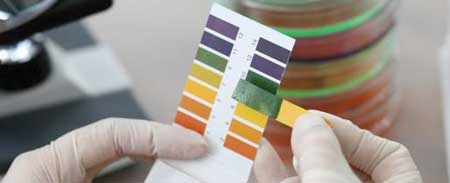| Sep 11, 2020 |
Novel virus-based colorimetric sensor can show true colors of airborne threats
|
|
(Nanowerk News) The ongoing COVID-19 pandemic has shown that the world needs technology that can quickly and accurately identify invisible dangers, including harmful substances or airborne environmental pollutants.
|
|
Colorimetric sensors--devices that intuitively reveal information about their environment through color changes--are an attractive option in this regard. But, for more people to benefit from these sensors, they must be easy to produce at a large scale. This is a major limitation with currently available colorimetric sensors, which require complex structures with intricate fabrication procedures. Other problems with existing devices include slow response times and unsaturated colors.
|
 |
| Colorimetric sensors are easy-to-use devices that can reveal information, such as humidity, acidity, or the concentration of certain chemicals, through color changes and an intuitive interface. (Image: Gwangju Institute of Science and Technology)
|
|
Now in a new study published in Advanced Science ("Large-Area Virus Coated Ultrathin Colorimetric Sensors with a Highly Lossy Resonant Promoter for Enhanced Chromaticity"), scientists at Gwangju Institute of Science and Technology, Korea, have attempted to tackle these limitations by developing a new type of colorimetric sensor made up of a thin layer of viruses called M13 bacteriophages.
|
|
They used this type of virus because it can change its structure--and thus its optical properties--in response to changes in the surrounding environment, such as the presence of harmful compounds. Prof Young Min Song, who led the study, explains, "In our study, we introduced the M13 bacteriophage, which is a nanometer-sized filamentous virus, as a sensing layer owing to its volumetrically expanding properties."
|
|
The scientists genetically engineered the M13 bacteriophages by combining them with a "highly lossy ultra-thin resonance promoter layer" (HLRP) as the substrate. Then, they maximized the resonance of the coating layer of the viruses by optimizing the substrate such that the bacteriophage became extremely sensitive toward specific airborne substances. This made it possible for the "viruses" to detect chemicals at very low concentrations--as low as tens of parts per billion.
|
|
Prof Song explains the technique, "Specifically, through optimization of the virus layer deposition, the virus layer was coated with ultra-thin dimension, which enhanced the detection rate. The HLRP with resonance enhancement was applied to obtain a distinct color even with a nanometer-scale thickness change in the M13 bacteriophage virus layer. Consequently, the color change was maximized by optimized resonance conditions."
|
|
The scientists tested the new sensor with environmental variables, like changes in humidity, and with compounds like volatile organic chemicals and endocrine disrupting chemicals. In both cases, changes in these stimuli could be successfully observed through distinct color changes in the sensor, thus showing its practical applicability.
|
|
This new design for highly effective and mass-producible colorimetric sensor holds much promise for a variety of real-life applications, such as detecting harmful industrial chemicals or assessing air quality. To top it all, these sensors could become invaluable tools in clinical settings, as Prof Song remarks, "In the future, advances in genetic engineering will enhance the sensitivity of the sensors and extend their applicability to the medical industry, where they could be used as diagnostic kits for detecting specific viruses and pathogens."
|
|
With further research, this technology will hopefully work as a powerful means to show the true colors of invisible airborne threats.
|

